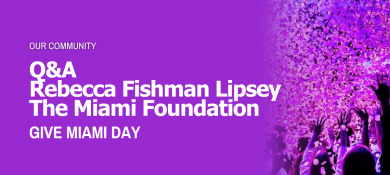
What’s a Tweet Worth?
By Bridget Carey
On a Thursday in July, just minutes before midnight, the Sunrise Ikea store was all a-Twitter. For two hours straight, 44 contestants pounded away at smartphones, pleading with any follower on Twitter to post or retweet a message with their team name. They raced to complete tasks through the empty Scandinavian furniture store, tweeting photos of meatball eating, lamp assembling, and bunk bed planking — all to win gift certificates.
The next morning, blogs celebrated a victory for the Twitter marketing experiment. Those involved boasted the event drew 8 million impressions on Twitter, the social networking site dedicated to all the news you can transmit in 140 characters or less.
Eight million what? For a late-night event, without prior media promotion, in a West Broward furniture store?
Businesses better brush up on the new vocabulary of social media marketers. As social networking sites like Facebook, Twitter and Foursquare have a growing importance in online marketing and engagement, companies are using a new suite of metrics to measure the success of an event or digital page. Thing is, there’s no agreed upon standard yet for measuring the value of a Tweet.
More established media formats are monitored by widely accepted third-parties. Magazines and newspapers use the Audit Bureau of Circulations, and television relies primarily on Nielsen. When it comes to Twitter, several companies are fighting to be the golden standard, including TweetReach, Twitalyzer, Klout, PeerIndex and Radian6. Because each employs a different algorithm, an online account can look popular and loved on one, and a dud on another. That makes metrics muddy when trying to prove ROI to a client.
In the case of Ikea’s event, eight million impressions — as measured by TweetReach — does not mean eight million eyeballs.
“We’re not asserting that we spoke to eight million people. That would be totally preposterous,” says event co-creator, Sara Shake of Exposed PR.
TweetReach defines impressions as how many times the messages could have been seen — that is, if every person who sent a message, as well as every one of their thousands of followers, stared at every message sent out about the event.
Shake and others say the more useful metric is “reach,” the total number of users that could have seen one post, which for this campaign was 700,000. She called the campaign an experiment in social media designed to spread a message as far as possible via popular South Florida Twitter users.
“It was just an exciting event and something that really hasn’t been done before,” Shake said of the high numbers. “We can’t pinpoint why, just like you can’t pinpoint why certain YouTube videos go viral.”
Twitter, estimated to have 21 million active users, is a place for anyone to share news, thoughts, recommendations or gripes with a public audience. Users will subscribe to follow the short, 140 character messages (known as tweets) from accounts they like, such as those who spread information about a specific niche interest.
With one click, users can share another person’s tweet with their followers (known as a retweet), and done on a large enough scale, it can make a message spread to a huge audience in seconds. And that feed of messages can easily be posted to eyeballs on other websites, including Facebook.
The evolution of marketing online has centered around leveraging the share power of Twitter, hoping to get someone not affiliated with a company or event to spread the word. It’s a digital version of the age-old concept: You trust what your peers recommend over a paid advertisement.
But there’s no way to tell when a Twitter user is looking at his or her account. So calculating reach, as is done now, is the equivalent of calculating how many people could have watched Anderson Cooper 360 last night because they have access to CNN.
Ikea doesn’t mind that it’s not an exact science. Its store traffic was up 20 percent the weekend after the event, and its sales rose 24 percent.
“We were certain that the event drove traffic to the store,” said Chantal Nichtawitz, marking manager at Ikea Sunrise. “That Saturday we had one of the biggest Saturdays we’ve seen in over a calendar year.”
The Adrienne Arsht Center also credits a Twitter campaign for boosting sales of Cirque Eloize iD to 43,000 tickets, making it the top selling summer show in the Center’s five year history.
Before the start of the show, which ran in July through September, screens by the stage curtain displayed in real-time messages on Twitter that included the hashtag phrase #cirqueid. It not only encouraged people to talk about the show and get their message seen by others in the audience, but it spread the word about the show to their outside connections.
“There really does seem to be a correlation with Twitter and Facebook and online sales,” said Andrew Goldberg, vice president of marketing at the Arsht Center. He says since the Tweets began, about 60 percent of the tickets have been bought online.
“That’s really astounding to us.” Goldberg said.
Goldberg’s staff also uses an online tool called Klout to measure how many influential Twitter users are spreading the word about the show. Klout measures influence by how much action and communication a user can stir up through retweets and comments, rather than counting the number of followers or friends.
In August, the #cirqueid phrase captured the attention of 65 new “influencers” and 323 “mentioners” — but Goldberg said the jury is still out on how much clout should be given to Klout’s numbers.
“So much of this is so new,” Goldberg said. “I remember 10 years ago, when new Web advertisers were pitching their online adverting and telling me they were having a million hits a day, and soon you learned a hit didn’t mean anything. What mattered was unique hits.”
Tools like Klout and PeerIndex put a number on a user’s social media importance — a type of credit score for the Twitter universe. Both websites use different equations to calculate how engaged they are with other users. Marketers then use those numbers to determine who should be invited to an event, or get free swag, hoping they’ll talk highly about it and get others to pay attention.
Virgin America gave away free flights last year to users with high Klout scores. Stephen King’s publisher, Scribner, gave Klout influencers the chance to download a free digital version of his new book, Mile 81, a week before it went on sale .
At Fashion’s Night Out at Bal Harbour Shops earlier this month, an event for local fashionistas to shop after hours, no one was allowed in the VIP lounge unless they had a Klout score of 40 or above — something supposedly only very active Twitter users can attain.
It would be the “the most socially-engaged fashion’s night out,” said Gerard Bush, chief creative director and co-founder of The brpr Group, which oversees social media marketing for Bal Harbour Shops.
The turn-out: 43 fashion-savvy, socially active attendees had the desirable score, including Tracy Wilson Mourning, wife of former Miami Heat star Alonzo Mourning. “We also had some baby boomers incredibly engaged with very high scores,” Bush said.
Did it get results? “The Klout Lounge had more press stories any other initiative,” he said, calling it “a great catalyst to create a dialogue” with socially engaged clients “who are able to spread the word” in a way not formerly possible. It also educates other shoppers about “harnessing the power of this new social technology.”
But when a fake spam account such as @armandoxf on Twitter can get a Klout score of 36 with four followers and more than 2,600 tweets of spam links, as was the case last week, how can such a measurement tool be taken seriously? (The spam account scored a zero on Klout competitor PeerIndex.)
“It’s definitely an evolving process,” said Klout Chief Executive Joe Fernandez, a University of Miami graduate, now based in San Francisco. “There’s still so much work to do.”
Fernandez said Klout has also worked with clients such as Disney and Nike. It’s becoming one of the most used measurement tools by marketing and public relations firms, as they hunt for voices that others care to listen to.
“Everyone wants to understand who had the ability to share something and have it cause ripple effects online,” Fernandez said.
Klout has started counting influence on YouTube and Foursquare but can only calculate followers on those platforms if the user in question has signed up to have his or her accounts tracked by Klout.
What would motivate someone to do that, and what does it matter to have a “thought leader” score of 45 or a “conversationalist” score of 23?
“We haven’t done a good job externally communicating what our scores mean,” Fernandez said.
Others in the space agree it’s a time of continuous adjustment.
“It certainly started as a wild west. I think we’re starting to settle the west a little,” said Jenn Deering Davis, co-founder of TweetReach in San Francisco. “By the end of 2012, we’ll see some stability.”
Until a tool can identify when a user has loaded messages and clicked on them, the measurements will likely remain uncertain. In the meantime, agencies are mashing together different scores to come up with their own analysis.
“I don’t think there’s a tool that we used yet where we got a number and didn’t scratch our head and look a little deeper” said Scott Thaler, executive vice president and chief interaction officer at Zimmerman Advertising in Fort Lauderdale.
For a year now, General Motors has worked with The Axis Agency to do Twitter-focused “crawls” around town, putting South Florida Twitter users in GM vehicles and asking them to Tweet throughout an afternoon of visiting a string of themed places, like pizza restaurants, cupcake shops and frozen yogurt parlors.
Stephanie Camargo Ruiz, who organizes events like Chevy Pizza Crawl and Chevy Cupcake Crawl, said the goal was to create a grassroots event with people who are passionate on Twitter, and to get them to test drive and talk about it — and that they did.
“It’s so hard to really gauge exactly what the results are,” Camargo Ruiz said. “We just wanted to get people into cars.”
Tadd Schwartz, principal at Schwartz Media Strategies in Coconut Grove, said he’s still educating clients on the metrics that matter. One repeated lesson: the number of followers or friends doesn’t matter, but it’s how they communicate with the brand.
“It’s not a numbers game,” Schwartz said. “It’s not quantity, it’s quality. It’s not about me coming in and dropping a three-foot-wide stack of clips on the table anymore.”
Yet businesses continue to pump up those numbers through promotions that generate a quick influx of friends or Tweets, such as promising rewards for following an account, retweeting a message or clicking “like’’ on a Facebook page.
“All that stuff is just spam, it’s clutter,” said Schwartz, who advises clients that it’s better to get five meaningful people on Twitter who care about your brand than to rack up the numbers.
Toby Srebnik, director of social media at public relations firm O’Connell & Goldberg, uses the metrics tools to monitor online reactions for campaigns with Aventura Mall and Anthony’s Coal Fired Pizza. But, he said, the numbers only matter if the client knows what they want to get out of social media.
“I do think at the end of the day, if you engage with your customers and you create that feeling of true community with them, I don’t think the score matters as much as the engagement you create with them,” Srebnik said. “If you can keep the warm feelings going, the sales will happen naturally.”
PDF / DOC File:




 See More Blogs
See More Blogs
Comments